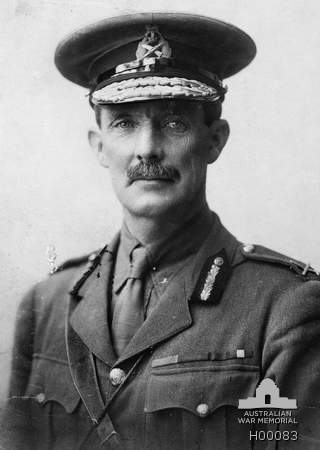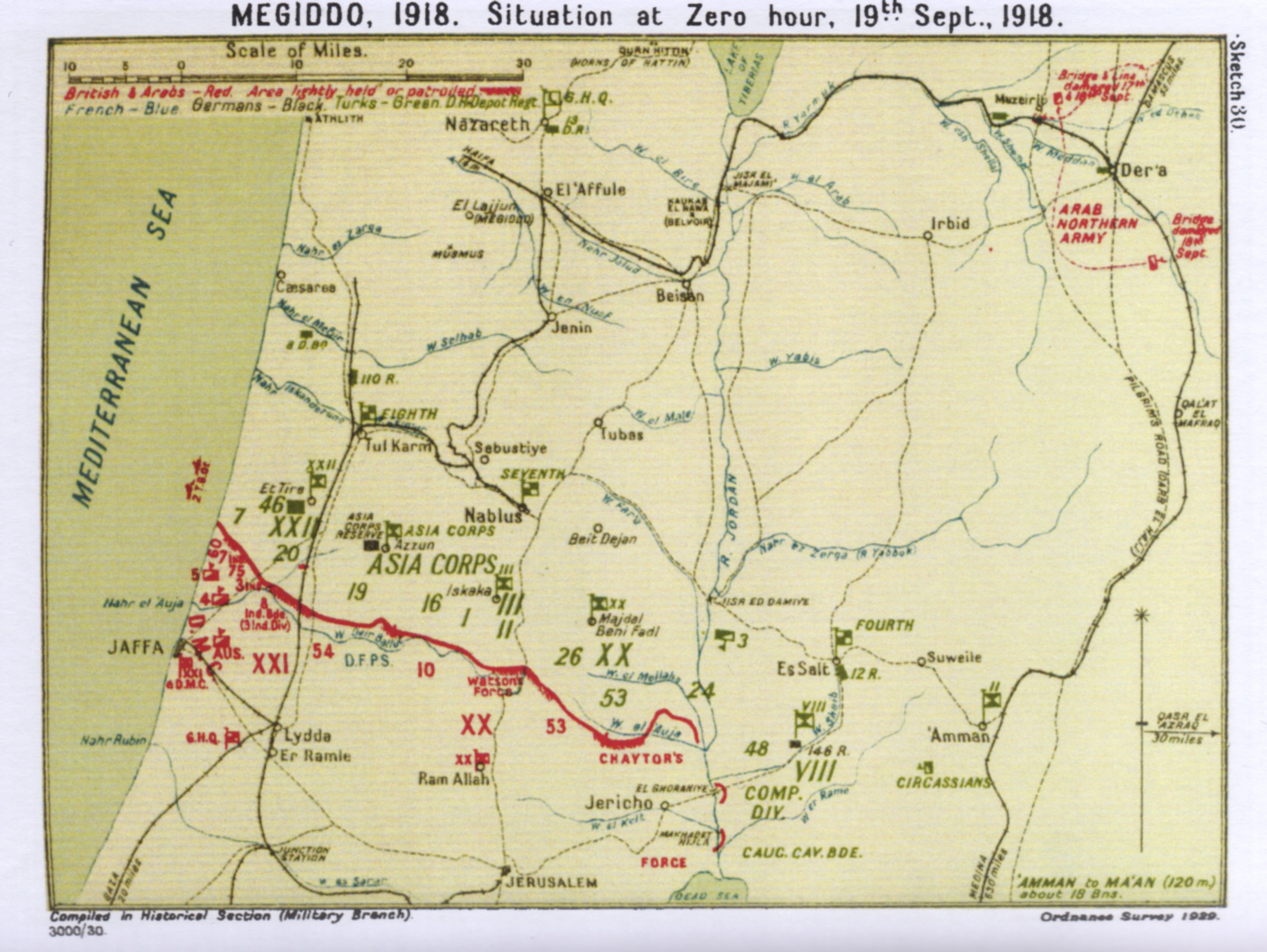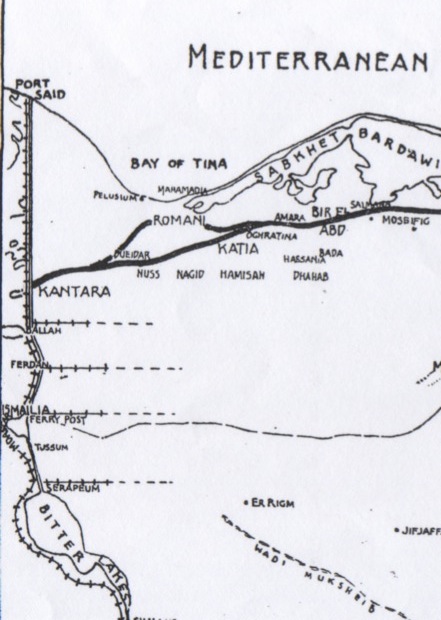|
Third Transjordan Attack
The Third Transjordan attack by Chaytor's Force, part of the British Empire's Egyptian Expeditionary Force (EEF), took place between 21 and 25 September 1918, against the Ottoman Empire's Fourth Army and other Yildirim Army Group units. These operations took place during the Battle of Nablus, part of the Battle of Megiddo which began on 19 September in the final months of the Sinai and Palestine campaign of World War I. Fought on the right flank and subsidiary to the Battle of Nablus, the Third Transjordan attack began northwards, with the assault on Kh Fasail. The following day a section of Chaytor's Force, attacked and captured the Ottoman Empire's 53rd Division ( Seventh Army) on the main eastwards line of retreat out of the Judean Hills across the Jordan River. Retreating columns of the Yildirim Army Group were attacked during the battle for the Jisr ed Damieh bridge, and several fords to the south were also captured, closing this line of retreat. Leaving detachments ... [...More Info...] [...Related Items...] OR: [Wikipedia] [Google] [Baidu] |
Middle Eastern Theatre Of World War I
The Middle Eastern theatre of World War I saw action between 30 October 1914 and 30 October 1918. The combatants were, on one side, the Ottoman Empire, with some assistance from the other Central Powers; and on the other side, the British Empire, British (with the help of Nili, a small number of Jews, Greeks, Armenians, some Kurdish tribes and Arab states, along with British Raj, Hindu, Sikh and Muslim colonial troops from India) as well as troops from the British Dominions of Australia, Canada, and New Zealand, the Russian Empire, Russians (with the help of Armenians, Assyrians, and occasionally some Kurdish tribes), and the French Third Republic, French (with its French North Africa, North African and French West Africa, West African Muslim, Christian and Traditional African religions, other colonial troops) from among the Allies of World War I, Allied Powers. There were five main campaigns: the Sinai and Palestine campaign, Sinai and Palestine, Mesopotamian campaign, Mesopo ... [...More Info...] [...Related Items...] OR: [Wikipedia] [Google] [Baidu] |
British Empire
The British Empire comprised the dominions, Crown colony, colonies, protectorates, League of Nations mandate, mandates, and other Dependent territory, territories ruled or administered by the United Kingdom and its predecessor states. It began with the English overseas possessions, overseas possessions and trading posts established by Kingdom of England, England in the late 16th and early 17th centuries, and colonisation attempts by Kingdom of Scotland, Scotland during the 17th century. At its height in the 19th and early 20th centuries, it became the List of largest empires, largest empire in history and, for a century, was the foremost global power. By 1913, the British Empire held sway over 412 million people, of the world population at the time, and by 1920, it covered , of the Earth's total land area. As a result, Westminster system, its constitutional, Common law, legal, English language, linguistic, and Culture of the United Kingdom, cultural legacy is widespread. ... [...More Info...] [...Related Items...] OR: [Wikipedia] [Google] [Baidu] |
Second Battle Of Amman
The Second Battle of Amman was fought on 25 September 1918 during the Third Transjordan attack as part of the Battle of Nablus which together with the main Battle of Sharon form the major set piece offensive known as the Battle of Megiddo of the Sinai and Palestine Campaign in World War I. After cutting the road from Nablus to Es Salt on 22 September Chaytor's Force captured the bridge over the Jordan River at Jisr ed Damieh while units of the Seventh Army and remnants of the Eighth Army were still in retreating towards the bridge from the Judean Hills. Having cut this line of retreat, Chaytor's Force proceeded eastwards to attack and capture Es Salt, before riding on to attack and capture the Ottoman rearguard of the Fourth Army defending Amman. These British Empire victories of the Third Transjordan attack over Yildirim Army Group forces, followed two unsuccessful EEF attacks across the Jordan River in March and April 1918. The Egyptian Expeditionary Force (EE ... [...More Info...] [...Related Items...] OR: [Wikipedia] [Google] [Baidu] |
Amman
Amman ( , ; , ) is the capital and the largest city of Jordan, and the country's economic, political, and cultural center. With a population of four million as of 2021, Amman is Jordan's primate city and is the largest city in the Levant region, the fifth-largest city in the Arab world, and the tenth-largest metropolitan area in the Middle East. The earliest evidence of settlement in Amman dates to the 8th millennium BC in 'Ain Ghazal, home to the world's oldest statues of the human form. During the Iron Age, the city was known as ''Rabat Aman'', the capital of the Ammonite Kingdom. In the 3rd century BC, the city was renamed ''Philadelphia'' and became one of the ten Greco-Roman cities of the Decapolis. Later, in the 7th century AD, the Rashidun Caliphate renamed the city Amman. Throughout most of the Islamic era, the city alternated between periods of devastation and periods of relative prosperity. Amman was largely abandoned during the Ottoman period from the 15 ... [...More Info...] [...Related Items...] OR: [Wikipedia] [Google] [Baidu] |
Salt, Jordan
Al-Salt ( ''Al-Salt''), also known as Salt, is an ancient trading city and administrative centre in west-central Jordan. It is on the old main highway leading from Amman to Jerusalem. Situated in the Balqa highland, about 790–1,100 metres above sea level, the city is built in the crook of three hills, close to the Jordan Valley. One of the three hills, Jabal al-Qal'a, is the site of a 13th-century ruined fortress. It is the capital of Balqa Governorate of Jordan. The Greater Salt Municipality has about 107,874 inhabitants (2018). In 2021, the city of Salt was inscribed at the UNESCO World Heritage list. Etymology The name "Salt" is derived from the Latin word ''saltus'', which means "forest". History It is not known when the city was first inhabited, but it is believed to have been built by the Macedonian army during the reign of Alexander the Great. The city was known as Saltus in Byzantine times and was the seat of a bishopric. At this time, the city was consi ... [...More Info...] [...Related Items...] OR: [Wikipedia] [Google] [Baidu] |
Shunet Nimrin
Ash-Shunah al-Janubiyah (), also Shoonah Janoobiyah, South Shuna or Southern Shouneh, etc., is a populated place in Balqa Governorate, Jordan, in the eastern Jordan Valley, not far from the place where the Jordan flows into the Dead Sea. The town stretches along the Jordan Valley Highway (HW 65) north of the intersection with Route 437 ( King Hussein Bridge Road), east of the Allenby (or King Hussein) Bridge and border crossing. It is the seat of the . South Shuna is the location of the cultural heritage site known as Shunet Nimrin / Shunat Nimrin. The Tell Nimrin archaeological site is within South Shuna.Environmental and Social Considerations in Detailed Planning Survey. The North Shuna-South S ... [...More Info...] [...Related Items...] OR: [Wikipedia] [Google] [Baidu] |
Capture Of Jisr Ed Damieh
The Capture of Jisr ed Damieh took place on 22 September 1918 during the Third Transjordan attack of the Battle of Nablus which, along with the main Battle of Sharon formed the Battle of Megiddo fought during the Sinai and Palestine Campaign of the First World War. Units of Chaytor's Force under the commanded by Brigadier-General William Meldrum, and known as "Meldrum's Force", attacked and captured the bridge. This successful attack cut the most direct line of retreat from the Judean Hills for the Seventh and remnants of the Eighth Armies, while units from these two armies were moving towards, and crossing the Jisr ed Damieh bridge over the Jordan River. This victory by Meldrum's Force opened the way for Chaytor's Force to advance along the main Nablus to Es Salt road to capture Es Salt and to continue on to the victory at the Second Battle of Amman. The main attack by the Egyptian Expeditionary Force (EEF), commanded by General Edmund Allenby, during the battle of Sharon ... [...More Info...] [...Related Items...] OR: [Wikipedia] [Google] [Baidu] |
Judean Hills
The Judaean Mountains, or Judaean Hills (, or ,) are a mountain range in the West Bank and Israel where Jerusalem, Bethlehem, Hebron and several other biblical sites are located. The mountains reach a height of . The Judean Mountains can be divided into a number of sub-regions, including the Mount Hebron ridge, the Jerusalem ridge and the Judean slopes. The Judaean Mountains formed the heartland of the Kingdom of Judah (930–586 BCE), where the earliest Jewish settlements emerged, and from which Jews are originally descended. Geography The Judaean Mountains are part of a more extended range that runs in a north-south direction. The ridge consists of the Samarian Hills in its northern part, and of the Judaean Mountains in its southern part, the two segments meeting at the latitude of Ramallah. The westward descent from the hard limestone country of the Judaean mountains towards the coastal plain is by way of a longitudinal trough of fosse cut through chalk, followed by the lo ... [...More Info...] [...Related Items...] OR: [Wikipedia] [Google] [Baidu] |
World War I
World War I or the First World War (28 July 1914 – 11 November 1918), also known as the Great War, was a World war, global conflict between two coalitions: the Allies of World War I, Allies (or Entente) and the Central Powers. Fighting took place mainly in European theatre of World War I, Europe and the Middle Eastern theatre of World War I, Middle East, as well as in parts of African theatre of World War I, Africa and the Asian and Pacific theatre of World War I, Asia-Pacific, and in Europe was characterised by trench warfare; the widespread use of Artillery of World War I, artillery, machine guns, and Chemical weapons in World War I, chemical weapons (gas); and the introductions of Tanks in World War I, tanks and Aviation in World War I, aircraft. World War I was one of the List of wars by death toll, deadliest conflicts in history, resulting in an estimated World War I casualties, 10 million military dead and more than 20 million wounded, plus some 10 million civilian de ... [...More Info...] [...Related Items...] OR: [Wikipedia] [Google] [Baidu] |
Sinai And Palestine Campaign
The Sinai and Palestine campaign was part of the Middle Eastern theatre of World War I, taking place between January 1915 and October 1918. The British Empire, the French Third Republic, and the Kingdom of Italy fought alongside the Arab Revolt in opposition to the Ottoman Empire, the German Empire, and the Austro-Hungarian Empire. It started with an Ottoman attempt at raiding the Suez Canal in 1915 and ended with the Armistice of Mudros in 1918, leading to the cession of Ottoman Syria. Fighting began in January 1915, when a German-led Ottoman force invaded the Sinai Peninsula, then occupied by the British as part of a Protectorate of Egypt, to unsuccessfully raid the Suez Canal. After the Gallipoli campaign, British Empire veterans formed the Egyptian Expeditionary Force (EEF) and Ottoman Empire veterans formed the Fourth Army, to fight for the Sinai Peninsula in 1916. In January 1917 the newly formed Desert Column completed the recapture of the Sinai at the Battle o ... [...More Info...] [...Related Items...] OR: [Wikipedia] [Google] [Baidu] |
Battle Of Megiddo (1918)
The Battle of Megiddo was fought between 19 and 25 September 1918, on the Plain of Sharon, in front of Tulkarm, Tabsor and Arara in the Judean Hills as well as on the Esdralon Plain at Nazareth, Afulah, Beisan, Jenin and Samakh. Its name, which has been described as "perhaps misleading" since very limited fighting took place near Tel Megiddo, was chosen by British commander Edmund Allenby for its biblical and symbolic resonance. The battle was the final Allied offensive of the Sinai and Palestine Campaign of World War I. The contending forces were the Allied Egyptian Expeditionary Force, of three corps including one of mounted troops, and the Ottoman Yildirim Army Group which numbered three armies, each the strength of barely an Allied corps. The series of battles took place in what was then the central and northern parts of Ottoman Palestine and parts of present-day Israel, Syria and Jordan. After forces of the Arab Revolt attacked the Ottoman lines of communication, dis ... [...More Info...] [...Related Items...] OR: [Wikipedia] [Google] [Baidu] |
Battle Of Nablus (1918)
The Battle of Nablus took place, together with the Battle of Sharon during the set piece Battle of Megiddo (1918), Battle of Megiddo between 19 and 25 September 1918 in the last months of the Sinai and Palestine campaign of the First World War. Fighting took place in the Judean Hills where the British Empire's XX Corps (United Kingdom), XX Corps attacked the Ottoman Empire's Yildirim Army Group's Seventh Army (Ottoman Empire), Seventh Army defending their line in front of Nablus. This battle was also fought on the right flank in the Jordan Valley, where Chaytor's Force attacked and captured the Jordan River crossings, before attacking the Fourth Army (Ottoman Empire), Fourth Army at Salt, Jordan, Es Salt and Amman capturing many thousands of prisoners and extensive territory. The Battle of Nablus began half a day after the main Battle of Sharon, which was fought on the Mediterranean section of the front line where the XXI Corps (United Kingdom), XXI Corps attacked the Eighth Army ... [...More Info...] [...Related Items...] OR: [Wikipedia] [Google] [Baidu] |






